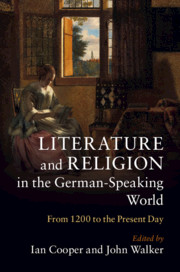Book contents
- Literature and Religion in the German-Speaking World
- Literature and Religion in the German-Speaking World
- Copyright page
- Contents
- Figures
- Contributors
- Introduction
- Chapter 1 Pagan, Christian, Secular
- Chapter 2 Literature and Religion in the Holy Roman Empire 1450–1700
- Chapter 3 German Literature and Religion 1700–1770
- Chapter 4 Literature and Religion in Germany 1770–1830
- Chapter 5 Culture, Society and Secularization
- Chapter 6 Religion in German Modernism 1900–1945
- Chapter 7 German Literature and Religion 1945 to the Present Day
- Notes
- Bibliography
- Index
Chapter 2 - Literature and Religion in the Holy Roman Empire 1450–1700
Published online by Cambridge University Press: 14 September 2019
- Literature and Religion in the German-Speaking World
- Literature and Religion in the German-Speaking World
- Copyright page
- Contents
- Figures
- Contributors
- Introduction
- Chapter 1 Pagan, Christian, Secular
- Chapter 2 Literature and Religion in the Holy Roman Empire 1450–1700
- Chapter 3 German Literature and Religion 1700–1770
- Chapter 4 Literature and Religion in Germany 1770–1830
- Chapter 5 Culture, Society and Secularization
- Chapter 6 Religion in German Modernism 1900–1945
- Chapter 7 German Literature and Religion 1945 to the Present Day
- Notes
- Bibliography
- Index
Summary
In no other period in the German-speaking lands was so much written about, and in the service of, religion as from 1450 to 1700. The chapter is divided into four sections. The first discusses the literature of exhortation and polemic. Before the Reformation this included The Ship of Fools (1494) by Sebastian Brant and the writings of Erasmus. From 1517 on it meant the religious debate spearheaded by Martin Luther. The second section demonstrates how drama was used for polemical and edificatory purposes in Reformation satire, Protestant Biblical drama, and both Catholic and Protestant historical drama. The third section analyses a cautionary tale from each side of the confessional divide: the Lutheran History of Dr John Faustus (1587) and the Catholic Grimmelshausen’s Simplicissimus (1669). The fourth section discusses the religious poetry of the seventeenth century, including that of Andreas Gryphius, the hymns of Paul Gerhardt and mystical poetry from Jakob Böhme to Catharina Regina von Greiffenberg.
Keywords
- Type
- Chapter
- Information
- Literature and Religion in the German-Speaking WorldFrom 1200 to the Present Day, pp. 46 - 84Publisher: Cambridge University PressPrint publication year: 2019

